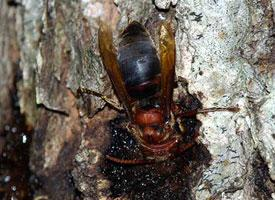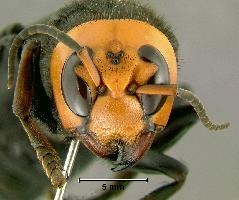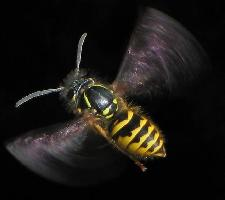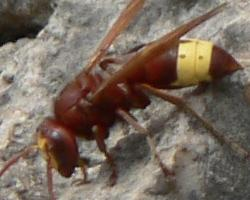
Váhy a míry
| Délka | od 17 do 30 mm |
|---|
Popis zvířete
The Black Hornet, scientifically known as Vespa dybowskii, is a captivating species within the hornet genus Vespa, belonging to the family Vespidae. This species, which primarily thrives in East Asia, is notable for its distinctive appearance and behavior, making it an interesting subject of study for entomologists and nature enthusiasts alike.Physical Description:
The Black Hornet boasts a robust body that exhibits a striking coloration predominantly of black with yellow accents. Adults can reach a body length of approximately 30mm, with queens being slightly larger than the workers. Their wings possess a dark, smoky hue which contrasts sharply with their body, while the eyes are keen and alert, reflecting a deep brown color. The antennae, which are crucial for navigation and sensing their environment, are black and highly sensitive. One of the most distinctive features of the Black Hornet is its mandibles, which are strong and capable of cutting through tough materials, aiding in both feeding and nest construction.
Habitat and Distribution:
Vespa dybowskii is predominantly found in the forests and rural areas of East Asia, including countries such as China, Korea, and Russia. They prefer habitats that provide ample food sources and nesting sites, such as wooded areas with plenty of tree cavities or underground burrows. The nests are often constructed in sheltered locations, including hollow trees and occasionally under eaves of buildings, made from chewed plant material mixed with saliva, creating a papery substance.
Behavior and Diet:
Black Hornets are known for their social structure, living in colonies that consist of a single queen, male drones, and numerous female workers. These colonies are highly organized, with each member playing a specific role in the survival of the nest. The workers are responsible for foraging, feeding the larvae, and protecting the nest, while the queen's primary role is to lay eggs.
Their diet primarily consists of insects, including flies, bees, and other small arthropods. The Black Hornet plays a crucial role in the ecosystem as a predator, helping to control the populations of other insects. However, they can also pose a threat to honeybee populations, as they are capable of launching coordinated attacks on bee hives to feed on the larvae.
Interaction with Humans:
While generally not aggressive towards humans, Black Hornets can become defensive if they perceive a threat to their nest. Their sting is painful and, in rare cases, can provoke allergic reactions. In areas where their habitat overlaps with human activity, it is advisable to exercise caution and avoid disturbing their nests.
Conservation Status:
Currently, there is limited information on the conservation status of Vespa dybowskii, but like many species, they face threats from habitat destruction and climate change. Further research and monitoring are necessary to understand their population trends and to develop strategies for their conservation.
In conclusion, the Black Hornet is a fascinating species with a complex social structure and significant role in the ecosystem. Their presence in the natural world underscores the intricate balance of predator-prey relationships and the importance of biodiversity. As with many species, understanding and respecting their role in the environment is crucial for coexistence and conservation.
Podobná zvířata
Nové fotografie zvířat
Top 10 zvířat
- Elephant hawk moth (Deilephila elpenor)
- Common house mosquito (Culex pipiens)
- Common cockchafer (Melolontha melolontha)
- Fruit fly (Drosophila melanogaster)
- Wasp spider (Argiope bruennichi)
- Australian box jelly (Chironex fleckeri)
- Colossal squid (Mesonychoteuthis hamiltoni)
- Moustached guenon (Cercopithecus cephus)
- Diana monkey (Cercopithecus diana)
- Common reed warbler (Acrocephalus scirpaceus)


